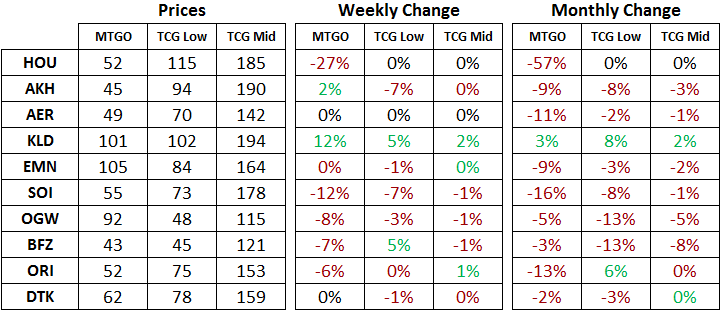Are you a Quiet Speculation member?
If not, now is a perfect time to join up! Our powerful tools, breaking-news analysis, and exclusive Discord channel will make sure you stay up to date and ahead of the curve.
Welcome to the MTGO Market Report as compiled by Matthew Lewis. The report will cover a range of topics, including a summary of set prices and price changes for redeemable sets, a look at the major trends in various Constructed formats and a "Trade of the Week" section that highlights a particular speculative strategy with an example and accompanying explanation.
As always, speculators should take into account their own budgets, risk tolerances and current portfolios before buying or selling any digital objects. Please send questions via private message or post below in the article comments.
Redemption
Below are the total set prices for all redeemable sets on MTGO. All prices are current as of July 17, 2017. The TCGplayer low and TCGplayer mid prices are the sum of each set's individual card prices on TCGplayer, either the low price or the mid price respectively.
All MTGO set prices this week are taken from GoatBot's website, and all weekly changes are now calculated relative to GoatBot's "full set" prices from the previous week. All monthly changes are also relative to the previous month's prices, taken from GoatBot's website at that time. Occasionally, full set prices are not available, and so estimated set prices are used instead. Although both Aether Revolt (AER) and Kaladesh (KLD) are no longer available for redemption, their prices will continue to be tracked while they are in Standard.
Standard
This week, Hour of Devastation (HOU) enters the price tracker for the first time, although this is the third week for MTGO price data. Champion of Wits is now the most expensive card in the set at over 8 tix. If this price is any indication of the Standard metagame, look for this blue rare to make an impact this weekend at Pro Tour HOU in Japan.
Rising sharply in the last two weeks is Chandra, Torch of Defiance from Kaladesh (KLD), which is closing in on Eldritch Moon (EMN) as the most expensive set in Standard. This card shows up in multiple Standard and Modern archetypes and has a price to match. Players should strongly consider purchasing their playsets if it dips back down into the low 20-tix range. Recent changes to Treasure Chests mean that this card is showing up on the curated card list, but the demand has been so strong that it is vying with Liliana, the Last Hope for most expensive card in Standard.
Speaking of KLD mythic rares, Angel of Invention is another big gainer this week, going from under 2 tix to now over 7 tix. It showed up as a three-of in this deck. It's unclear whether or not this archetype will have any staying power, but a strong finish at Pro Tour HOU will push this card over 10 tix.
From a more general perspective, the four sets rotating out of Standard in the fall will be dropping in price over the coming weeks as the utility of the cards in each set drops substantially. Fortunately, Battle for Zendikar (BFZ), Oath of the Gatewatch (OGW), Shadows Over Innistrad (SOI) and EMN will all still be available for redemption, so there will be a predictable shift of value into the mythic rares of each set. Savvy speculators will look to cards like Wolf of Devil's Breach as a good target at the current price of less than 0.05 tix. Do not overpay for any one card, and be sure to diversify across cards if you are going to pursue a bulk mythic rare strategy.
Modern
As we get closer to Standard rotating in the Fall, it's a good idea to start sizing up the cards from SOI and BFZ blocks that are Modern playable. These cards will go on sale in October and November, so thinking in advance about which ones to target is a good idea.
Spell Queller has always been an intriguing card that seemed like it had Modern potential. The fact that it was recently one of the most expensive rares in Standard gives it a good pedigree for a future high price based on its possible play in Modern. Well, a deck featuring this card was published this week as one of the decks going 5-0 in the Modern leagues on MTGO. Check it out here.
This deck is quite novel and appears to be able to take opponents unaware. I would not expect this list to put up consistent 5-0 finishes in the league, but the appearance of Oketra's Monument, Reflector Mage and Spell Queller in a deck cannot be discounted. It looks like the deck has enough tempo elements to win slowly but surely off of the mana and board advantage created by Oketra's Monument. Having access to the premium sideboard hosers available to white is also great. I'm sure this is not the last Modern deck we'll see Spell Queller in, but I am doubtful this will be the best deck it shows up in.
Other cards that are Modern playable from these two blocks include Collective Brutality, Gideon, Ally of Zendikar, Tireless Tracker, Cinder Glade, Grim Flayer, Liliana, the Last Hope, Nahiri, the Harbinger, Ulamog, the Ceaseless Hunger, and the Eldrazi from OGW. You won't go wrong targeting these cards in the fall.
Trade of the Week
For a complete look at my recent trades, please check out the portfolio. This week I started selling boosters as a way to build liquidity. My position in AKH boosters was small and the outlook short term in nature, so this is a perfectly natural time to harvest profits on theses, but for KLD and AER boosters, the reasoning is different.
The price on a draft set of KLD block boosters has more or less been moving up since the release of AKH. Two boosters of AER and one of KLD bottomed at below 7 tix back at the end of April, and they now sit at 8.4 tix. Although still shy of my target price of 9 tix, and at least six weeks left of demand from drafters, it's clear that this is not the price peak on these. However, speculating successfully involves more than just timing price fluctuations correctly. There are two very good reasons to sell in advance of a probable price peak.
The first is when you are holding a large position that will take time to unwind. In a low volume market such as non-current Draft sets, selling a large position all at once will cause a drop in the price of the boosters. This type of activity is counterproductive to the goal of profit making, so a measured pace of selling will allow the market to absorb the supply I am introducing into the market. Selling a little bit, piece by piece over a period of weeks, will take patience, but it will also maintain a higher average selling price than dumping the whole position all at once. This is conditional on the the market remaining stable.
The second reason is less strategic but is specific to the portfolio. I'm tix-constrained at the moment, which means that I have few available tix ready to be deployed. It's always best practice to have some tix on hand in case of a short-term opportunity, so selling down this position in order to build up my stock of tix makes sense. We are also clear of the liquidity crunch that resulted from the release of HOU, so selling into a more normal market is fine. For any portfolio that is a little light on tix, it's wise to sell your positions when you can and not when you are forced to.






